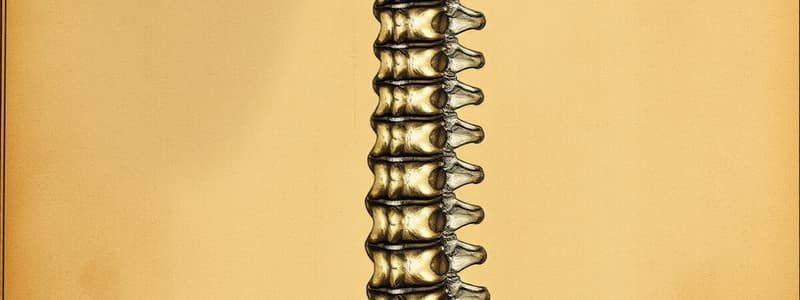Podcast
Questions and Answers
What is a Compression Fx-1?
What is a Compression Fx-1?
What is the orthotic management for a Burst Fx-2?
What is the orthotic management for a Burst Fx-2?
What are the fracture characteristics of a Seat Belt Injury-3?
What are the fracture characteristics of a Seat Belt Injury-3?
Fracture of the middle and posterior aspect
What is the goal of orthotic management for a Dislocation Fx-4?
What is the goal of orthotic management for a Dislocation Fx-4?
Signup and view all the answers
Define Nonstructural curve.
Define Nonstructural curve.
Signup and view all the answers
Define Structural curve.
Define Structural curve.
Signup and view all the answers
What characterizes a Compensated curve?
What characterizes a Compensated curve?
Signup and view all the answers
What does Decompensated curve refer to?
What does Decompensated curve refer to?
Signup and view all the answers
What is the purpose of the Risser Sign/Scale?
What is the purpose of the Risser Sign/Scale?
Signup and view all the answers
What types of spinal curves are identified?
What types of spinal curves are identified?
Signup and view all the answers
List some clinical assessment indicators for spinal issues.
List some clinical assessment indicators for spinal issues.
Signup and view all the answers
Study Notes
Spine Fracture Management
-
Compression Fracture (Fx-1): Involves only the anterior portion of the spine. Managed with orthoses like Jewett, CASH, bivalve TLSO, or LSO if the fracture is mild and stable. The goal is to implement a 3-point force system, provide kinesthetic reminders, and prevent forward flexion.
-
Burst Fracture (Fx-2): Affects both anterior and middle columns of the spine. Orthotic treatment typically includes a custom bivalve TLSO or Jewett brace for stable fractures. Aims to increase intracavitary pressure to relieve stress on the spine, facilitate spinal alignment, and limit motion.
-
Seat Belt Injury (Fx-3/Chance): Characterized by fractures in the middle and posterior aspects of the spine. Managed with a custom bivalve TLSO to ensure immobilization, pain reduction, and spinal alignment.
-
Dislocation Fracture (Fx-4): Involves damage to the anterior, middle, and posterior columns. Requires surgical intervention followed by the use of a custom bivalve TLSO. The management goals are to promote healing, prevent fracture progression, provide immobilization, and reduce pain.
Scoliosis Classification
-
Nonstructural Scoliosis: Represents a lateral spine curve that lacks rotation and is reversible without any structural changes.
-
Structural Scoliosis: Characterized by a lateral curve that includes rotation within major curves, making it irreversible.
-
Compensated Scoliosis: Refers to secondary curves formed above or below a major curve, resulting in the head appearing midline over the pelvis with level shoulders.
-
Decompensated Scoliosis: Occurs when the major curve is more pronounced than the secondary curve, leading to uneven shoulders and a displaced head.
Risser Sign/Scale
- The Risser sign assesses skeletal maturity based on the extent of iliac crest ossification.
- Grade 1: 25% ossification indicates the beginning of skeletal maturity.
- Grade 2: 50% ossification suggests considerable growth remains.
- Grade 3: 75% ossification indicates minimal growth left.
- Grade 4: 100% ossification confirms the end of growth.
Curve Types
- Spine curves can be categorized as:
- C-shaped thoracolumbar
- Thoracic and lumbar double curves
- Single lumbar C-shaped curves
- Primary thoracic curves
Clinical Assessment
- Clinical indicators of spinal issues include:
- Head appears slightly off-center.
- Shoulders uneven, with one blade sitting higher.
- Notable asymmetry of the back and visible curvature.
- One hip positioned higher than the other.
- Rib prominence observed when bending over.
- Asymmetry in the ribs or chest shape.
Studying That Suits You
Use AI to generate personalized quizzes and flashcards to suit your learning preferences.
Description
Test your knowledge on Spine Fracture Management using the Denis Classification system. This quiz focuses on the different types of fractures, their characteristics, and appropriate orthotic management strategies. Perfect for healthcare professionals and students studying spinal injuries.




